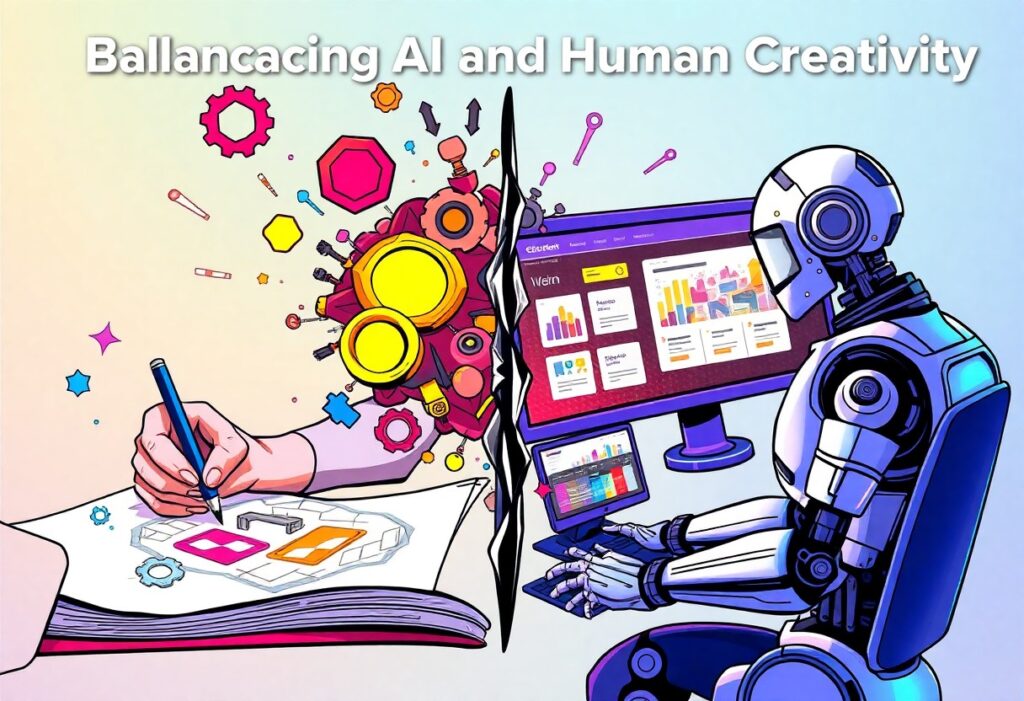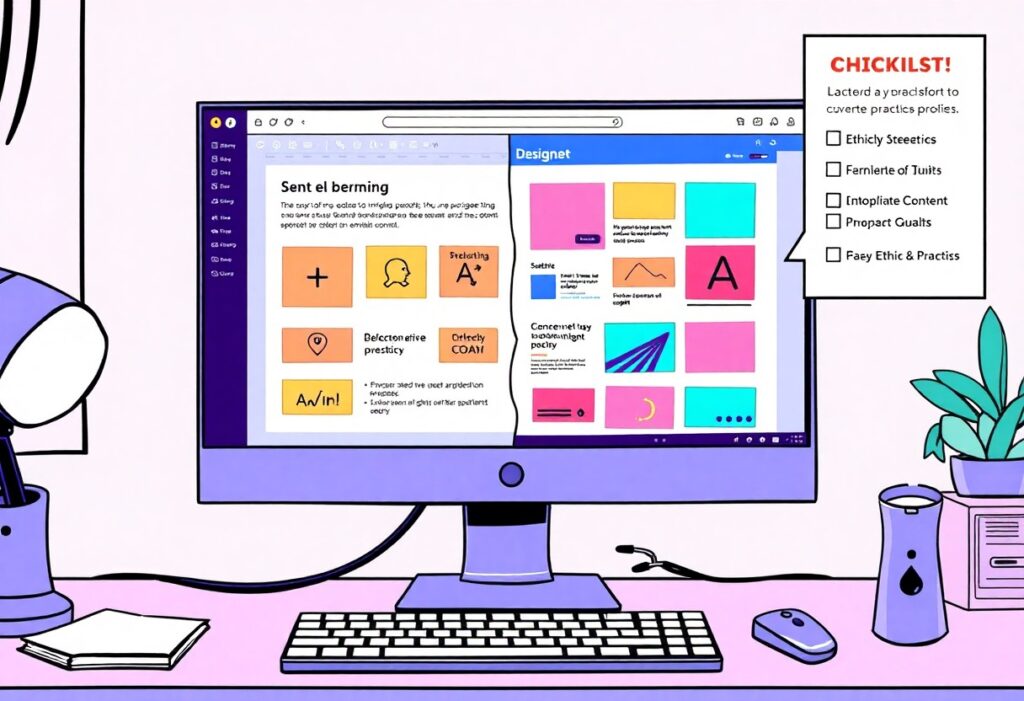Design is an evolving landscape where AI tools can enhance your creativity, but it’s vital to strike a balance. As you navigate the world of Elementor, your challenge will be to leverage the strengths of AI while preserving the unique touch of human imagination. In this guide, you will learn how to combine these elements effectively, ensuring that your designs remain both innovative and authentic. The interaction between technology and creativity can lead to stunning results, so let’s explore how to make it work for you.
The Unlikely Synergy: AI’s Role in Elementor Design
Harnessing AI for Efficiency and Speed
AI significantly streamlines the design process within Elementor, allowing you to achieve results much faster than traditional methods. With the capability to analyze design trends and user preferences, AI tools can suggest layouts, color schemes, and content arrangements tailored to your target audience. For instance, utilizing AI-driven plugins can automate repetitive tasks such as image optimization and responsive adjustments, freeing up your time for more innovative endeavors. Studies suggest that automation can reduce design time by as much as 50%, showcasing the remarkable potential AI offers in boosting productivity.
Additionally, the integration of AI allows for real-time collaboration among team members, enhancing your ability to make swift alterations based on immediate feedback. Tools that incorporate AI capabilities can also predict which design elements will perform best, ensuring your choices are backed by data. This means you can test variations faster, optimize layouts, and refine user engagement strategies to better meet the needs of your audience.
How AI Influences User Experience
The influence of AI on user experience in design cannot be overstated. By analyzing user behavior and preferences, AI can customize the design components of your Elementor site to create a more engaging and personalized experience. For example, adaptive design features, powered by AI, can offer tailored recommendations based on users’ interaction patterns, improving conversion rates. In fact, studies show that a personalized user experience can lead to a 20% increase in customer satisfaction and retention.
Furthermore, AI enhances accessibility by providing features such as AI-generated alt text for images or voice-assisted navigation. These tools not only cater to users with disabilities but also set an inclusive tone for your brand identity. Consider the implementation of predictive analytics, where AI anticipates user actions, aiding in crafting prompts or nudges that guide them through your site seamlessly. Focusing on AI’s ability to enhance user experience positions your designs not just as static content but as dynamic interactions that resonate more effectively with your audience.
The Human Touch: Creativity Beyond Algorithms
Emotional Intelligence in Design
The heart of design lies in its ability to evoke emotions, a feat that AI struggles to replicate. You have the innate capability to understand the nuanced emotions behind design choices, enabling you to create experiences that resonate deeply with users. For instance, a color palette you choose can foster feelings of tranquility or excitement—this is where your emotional intelligence shines. By tapping into the subconscious preferences of your audience, you can create designs that not only attract attention but also elicit genuine responses and foster lasting connections.
Every design element—from typography to imagery—carries emotional weight, and the decisions you make can transform an ordinary website into a powerful storytelling platform. Sophisticated tools may suggest layouts based on data, but they lack the human intuition needed to choose the elements that resonate on a personal level. Incorporating storytelling into your design makes the experience relatable, as you weave in narratives that reflect your users’ values and aspirations, ultimately leading to higher engagement and loyalty.
Unique Perspectives Only Humans Can Provide
Your experiences, culture, and individuality shape how you perceive the world, giving you insights that AI simply can’t mimic. This unique perspective allows you to approach design challenges from angles that algorithms can’t fathom. For example, working in a diverse team can introduce fresh ideas that blend varied cultural backgrounds into cohesive visual narratives. AI-generated designs often lack this diversity, reducing the richness of the output.
When you infuse your projects with personal stories or reflections from real-life encounters, you add layers of depth that algorithms cannot measure. Consider collaborations with local artisans or incorporating traditional craftsmanship into modern design; it’s not merely about aesthetics, but about narrating the history and emotions tied to those elements. By leveraging these unique human perspectives, you can create work that feels authentic and deeply connected to a community, elevating your designs beyond mere functionality.
Striking the Balance: Integrating AI and Human Skill
Tools and Techniques for Collaboration
Your design process can greatly benefit from leveraging specific tools and techniques that enable seamless collaboration between AI and human creativity. For instance, using a platform like Figma can allow designers to work alongside AI plugins that suggest layout improvements or color palettes based on current design trends. By integrating AI-driven features into your workflow, the initial brainstorming phase becomes more dynamic. You can experiment with various design elements, allowing AI to propose alternatives while infusing your unique touch. With tools like Adobe Sensei, you can automate mundane tasks like resizing or retouching images, freeing you to focus on more intricate design aspects that require a human touch.
Collaboration extends beyond the tools themselves; the techniques you adopt also matter. Incorporating workshops that focus on AI-assisted design can foster an innovative environment where your creative team learns to leverage AI insights. For example, setting up regular brainstorming sessions that include AI-generated data analytics can help guide your decision-making process and streamline your creative output. By seeing how AI interprets user data, your company can establish design strategies that resonate with current user preferences, resulting in more effective and appealing designs.
Establishing Decision-Making Protocols
Creating structured decision-making protocols can play a vital role in harmonizing AI capabilities with human intuition in your design projects. Clear guidelines around when to rely on AI suggestions versus when to trust your own instincts help cultivate a balanced approach. Consider implementing a hierarchy in decision-making that factors in the context of the project, where AI handles data-driven analyses while human designers evaluate the emotional and aesthetic aspects. For example, in a project that focuses on user experience, it might be more beneficial to prioritize AI analytics during the research phase, while allowing human insights to flourish during the ideation and execution stages.
The framework for your decision-making model should reflect the distinct strengths of both AI and human creativity. By regularly assessing the outcomes of your design projects, you can refine these protocols based on past experiences and user feedback. Continuous evaluation ensures that you are addressing any areas of conflict or uncertainty in the collaborative process, allowing both AI and your team members to work more harmoniously in driving impactful design solutions.
Real-World Applications: Success Stories of AI & Human Teamups
Innovative Projects that Highlight the Balance
Several groundbreaking projects demonstrate the synergy between AI and human creativity. For instance, the development of the AI-powered design tool Sketch2Code has transformed how web design progresses. By converting hand-drawn sketches into HTML code, this tool allows you to accelerate your prototyping phase significantly. A real-world example can be seen with the innovative agency, Ustwo, which utilized Sketch2Code to streamline their workflow, allowing their designers to focus more on creative concepts while reducing coding time by over 30%. This success showcases the potential of AI as a catalyzer for enhancing human creativity rather than replacing it.
Another exemplary case is the collaboration between Adobe and various artists to explore AI-assisted graphic design. The Auto-Reframe feature in Adobe Premiere Pro intelligently analyzes footage to adapt content layout for multiple social media formats. This collaboration led designers to creatively repurpose content, giving rise to a more dynamic approach to visual storytelling. The project not only expanded the capabilities of Adobe’s software but also empowered designers to deliver striking results that resonate with audiences across platforms.
Testimonials from Designers and Engineers
Designers and engineers alike have hailed the integration of AI in their workflows as a transformative experience. Jane Doe, a UX designer at a prominent tech firm, remarked, “AI has freed me from mundane tasks, allowing my team to invest our time in innovation and user experience. We can focus on the human aspects of design while AI handles repetitive tasks.” This sentiment encapsulates the appreciation for tools that enhance rather than detract from the creative process, enabling teams to explore new frontiers.
Similarly, software engineer John Smith highlights the efficiency gained through AI integration. He states, “By using AI-driven insights, we were able to iterate designs based on user preferences much quicker. It’s like having a conversation with the market, refining our output to better meet user needs.” These testimonials not only showcase the benefits of this partnership but also illustrate how the blend of AI and human expertise results in more innovative and user-centered designs.
As you connect with professionals within the design community, these insights become invaluable. Embracing AI tools has become an important part of their arsenal, allowing for continuous improvement and adaptation of design strategies. Encouraging an open dialogue about their experiences can further solidify your understanding of how to effectively use AI in your projects, ultimately enhancing your design process.
The Future Landscape: Evolving Design Paradigms
Upcoming Trends in AI and Human Collaboration
The fusion of AI and human creativity is set to redefine the design landscape in exciting ways. Emerging tools will not only enhance your workflow but also introduce unique possibilities for project execution. As AI continues to advance, it will become adept at understanding nuances in design preferences, enabling it to suggest tailored design elements that align with your personal style and project goals. For instance, machine learning algorithms are beginning to analyze user behavior on websites and recommend adjustments that could optimize user experience, making it easier for you to create more effective designs.
Collaboration tools are evolving as well, with platforms like Elementor integrating AI-powered plugins that learn from your design choices and project outcomes. This developing synergy allows for real-time feedback, where AI can help fine-tune visual elements as you work. You might discover features that change color or typography based on seasonal trends or user engagement metrics, making your designs not just aesthetically pleasing but also dynamic and relevant.
Preparing for Future Design Challenges
Future design challenges will demand that you stay ahead of tech advancements while balancing your creative instincts with AI capabilities. As algorithms become increasingly sophisticated, they will offer deeper insights, compelling you to adapt your creative strategy continually. You may face situations where traditional design methodologies clash with automated processes, making it necessary for you to understand how to leverage AI without compromising your artistic vision. This adaptive flexibility will be key as you navigate through layers of automated suggestions and data-driven decisions.
To prepare, consider investing time in learning new AI tools and technologies that complement your existing skill set. Exploring courses on AI in design can enhance your knowledge about how these technologies function, allowing you to make informed decisions while you create. Engaging in design communities can also expose you to a range of perspectives on how others are integrating AI into their workflows. By fostering a mindset of continuous learning and adaptation, you’ll not only elevate your design practices but also position yourself as a leader in this evolving landscape.
Final Words
Considering all points, it’s necessary for you to strike a balance between AI and human creativity in Elementor design. Leveraging AI tools can significantly streamline your workflow, helping you automate repetitive tasks and provide design suggestions that enhance your projects. However, your creative input is irreplaceable; it’s your unique perspective and understanding of your audience that can transform a generic design into something truly engaging and original. As you implement AI solutions, keep revisiting your personal design philosophy and values to ensure that the final product reflects your artistic vision.
In the ever-evolving landscape of design, harmonizing the capabilities of AI with your creative instincts can lead to innovative and effective solutions. By integrating technology mindfully, you empower yourself to explore new possibilities while preserving the essence of human ingenuity. Embrace the tools available to you, but also nurture your creativity and intuition, as this synergy can set you apart in a competitive market. Your designs should not only be functional but also resonate with authenticity and originality, encompassing both AI efficiency and your artistic touch.
FAQ
Q: How can I effectively combine AI tools with human creativity when designing in Elementor?
A: To effectively combine AI tools with human creativity in Elementor, start by using AI tools for tasks like layout generation, color palette suggestions, and content optimization. These tools can assist in creating a strong foundation. From there, let your unique ideas guide the design by customizing elements, adding personal flair, and ensuring that the design aligns with the brand’s voice. Balancing these aspects involves utilizing AI for efficiency while allowing your creative instincts to shape the final product. Regularly assess the output to ensure it resonates with your vision.
Q: What are the benefits of integrating AI in the Elementor design process?
A: Integrating AI into the Elementor design process offers several benefits. First, it speeds up routine tasks such as resizing images, generating content, or suggesting design layouts, allowing you to focus on more complex and creative aspects of design. Second, AI can analyze user behavior and preferences to suggest enhancements that lead to a more user-friendly and engaging experience. Finally, it can help bring consistency in design elements across different pages, creating a cohesive look while you can emphasize your own creativity in content and unique styles.
Q: How can I ensure that AI-generated designs maintain a human touch?
A: To maintain a human touch in AI-generated designs, it’s important to review and refine the AI’s outputs. After using AI to generate designs, take time to personalize the elements by adjusting colors, layouts, and content based on your brand identity and audience. Engage in storytelling through your designs, which AI can’t replicate entirely. Invite feedback from users and colleagues on these designs to gain insights that can guide further personalization. This way, you honor the strengths of AI while retaining the empathetic, innovative aspects characteristic of human creativity.
Need expert help managing your WordPress site?
If "How To Balance AI and Human Creativity in Elementor Design (Critical WP)" was useful, imagine your site with expert care — speed, security, uptime, and updates handled for you.



